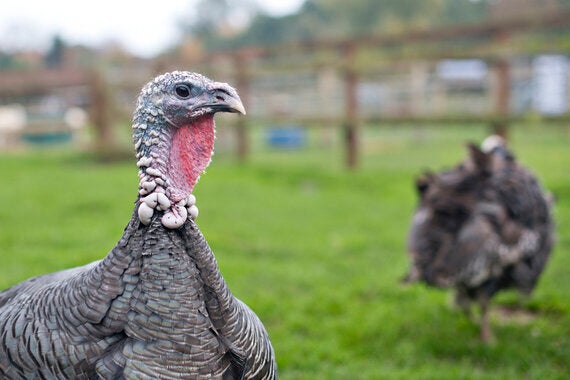At this time of year, we're used to being bombarded with adverts for turkey - the kind that's served up on a plate and made to look as far removed as possible from what was once a living creature. But this year, Vodafone's Terry the Turkey film has introduced a very different perspective. For anyone who hasn't seen the advert, it tells the story of a family who buy a turkey to raise and slaughter for Christmas, but the personal connection they develop with him means that they can't go through with their plans. The final scene shows the father of the family taking a nut roast out of the oven, while the turkey sits at the head of the table. The advert was shown on national TV and has been viewed more than a million times on Youtube.
There's no doubt that Terry the Turkey helped people to see these long-suffering birds differently, and that's been a focus for us at Animal Aid too. Last month I was lucky enough to visit a group of rescued turkeys at Hillside Animal Sanctuary in Norfolk, some of whom were saved from the intensive farming industry. As an animal rights campaigner, I didn't need to be convinced that turkeys are individuals with feelings, but even I was amazed at what unique and diverse characters they have.
We'd planned to film Tessa, a turkey who is on Hillside's adoption scheme, but she turned out to be rather shy of the limelight. She preferred to let the other turkeys approach us first, and hang back in the barn with her favourite companion. The star of the show was undoubtedly a spectacular turkey called Millie, who crowed assertively at the camera, and repeatedly dived in front of the other turkeys when we were trying to film them. A small white turkey called Laura shared Tessa's more cautious approach, and still bore the scars of the industry she'd been rescued from. She'd had the tip of her beak sliced off - which is a common practice on turkey farms - and she struggled to eat the grapes and cooked peas that we gave out.
The film we created featuring the Hillside turkeys
During our latest investigation inside a turkey farm, we found animals just like Laura, Tessa and Millie packed into a dark, cramped shed. The footage we captured shows a filthy, stressful environment, and birds with missing feathers and sore skin. If these turkeys had been allowed to live and removed from this hellish environment, we'd undoubtedly have found that they were just as charismatic as the Hillside turkeys.
All this talk of factory farming may leave you seeking out a so-called 'higher-welfare' turkey, but no matter how they are reared, all farmed turkeys meet a terrifying and brutal end at the slaughterhouse. They are either gassed, or are hung upside down by their legs and dipped into a basin of electrified water before having their throats cut. If the general public witnessed this process, I very much doubt that they would view their roast turkey in the same way.
Fortunately, choosing not to support this kind of cruelty is no barrier to enjoying an indulgent Christmas dinner. Faux meats have made huge progress in recent years (brands like Vegusto, Fry's, VBites and Tofurky all produce excellent substitutes) or you can make delicious vegan centrepieces yourself (I find the best ones usually involve puff pastry and a rich filling). You might also like to check out the Christmas recipes in Animal Aid's Compassionate Christmas guide.
Tessa, Laura and Millie will be spending Christmas at Hillside, while the eight turkeys used in the Vodafone advert are living at the Farm Animal Rescue Sanctuary in Warwickshire. Please remember them when you plan your Christmas dinner, and choose a cruelty-free option with a clear conscience.

Copyright: Chris Shoebridge